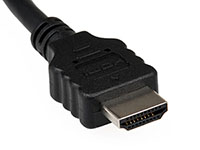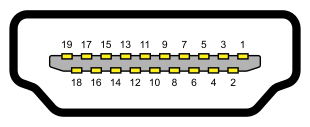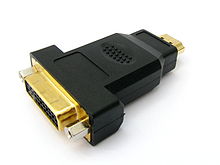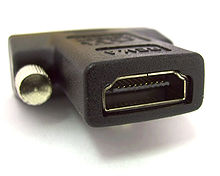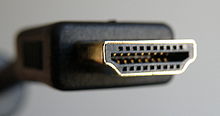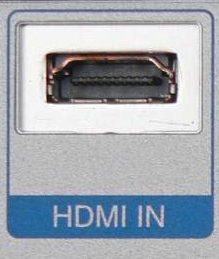HDMI Versions_2
HDMI (High-Definition Multimedia Interface) is a compact audio/video interface for transferring uncompressed videodata and compressed or uncompressed digital audio data from a HDMI-compliant source device to a compatible computer monitor, video projector, digital television, or digital audio device.HDMI is a digital replacement for existing analog videostandards.
HDMI implements the EIA/CEA-861 standards, which define video formats and waveforms, transport of compressed, uncompressed, and LPCM audio, auxiliary data, and implementations of the VESA EDID.CEA-861 signals carried by HDMI are electrically compatible with the CEA-861 signals used by the digital visual interface (DVI). No signal conversion is necessary, nor is there a loss of video quality when a DVI-to-HDMI adapter is used. The CEC (Consumer Electronics Control) capability allows HDMI devices to control each other when necessary and allows the user to operate multiple devices with one remote control handset.
Several versions of HDMI have been developed and deployed since initial release of the technology but all use the same cable and connector. Newer versions optionally support advanced features such as 3D, an Ethernet data connection and improved audio and video capacity, performance and resolution.
Production of consumer HDMI products started in late 2003. In Europe either DVI-HDCP or HDMI is included in the HD ready in-store labeling specification for TV sets for HDTV, formulated by EICTA with SES Astra in 2005. HDMI began to appear on consumer HDTV camcorders and digital still cameras in 2006.As of January 8, 2013 (ten years after the release of the first HDMI specification), over 3 billion HDMI devices have been sold.
HDMI (High-Definition Multimedia Interface)
|
Type : Digital audio/video/data connector
|
on consumer HDTV camcorders and digital still cameras in 2006.As of January 8, 2013 (ten years after the release of the first HDMI specification), over 3 billion HDMI devices have been sold.
History
The HDMI Founders are Hitachi, Matsushita Electric Industrial (Panasonic/National/Quasar), Philips, Silicon Image, Sony,Thomson, RCA and Toshiba.Digital Content Protection, LLC provides HDCP (which was developed by Intel) for HDMI.HDMI has the support of motion picture producers Fox, Universal, Warner Bros. and Disney, along with system operators DirecTV, EchoStar (Dish Network) and CableLabs.
The HDMI Founders began development on HDMI 1.0 on April 16, 2002, with the goal of creating an AV connector that was backward-compatible with DVI. At the time, DVI-HDCP (DVI with HDCP) and DVI-HDTV (DVI-HDCP using the CEA-861-B video standard) were being used on HDTVs.HDMI 1.0 was designed to improve on DVI-HDTV by using a smaller connector and adding support for audio, and enhanced support for YCbCr and consumer electronics control functions.
The first Authorized Testing Center (ATC), which tests HDMI products, was opened by Silicon Image on June 23, 2003, in California, United States.The first ATC in Japan was opened by Panasonic on May 1, 2004, in Osaka. The first ATC in Europe was opened by Philips on May 25, 2005, in Caen, France.The first ATC in China was opened by Silicon Image on November 21, 2005, in Shenzhen. The first ATC in India was opened by Philips on June 12, 2008, in Bangalore.The HDMI website contains a list of all the ATCs.
According to In-Stat, the number of HDMI devices sold was 5 million in 2004, 17.4 million in 2005, 63 million in 2006, and 143 million in 2007. HDMI has become the de facto standard for HDTVs, and according to In-Stat, around 90% of digital televisions in 2007 included HDMI. In-Stat has estimated that 229 million HDMI devices were sold in 2008. On April 8, 2008 there were over 850 consumer electronics and PC companies that had adopted the HDMI specification (HDMI Adopters).On January 7, 2009, HDMI Licensing, LLC announced that HDMI had reached an installed base of over 600 million HDMI devices.In-Stat has estimated that 394 million HDMI devices will sell in 2009 and that all digital televisions by the end of 2009 would have at least one HDMI input.
On January 28, 2008, In-Stat reported that shipments of HDMI were expected to exceed those of DVI in 2008, driven primarily by the consumer electronics market.
In 2008, PC Magazine awarded a Technical Excellence Award in the Home Theater category for an "innovation that has changed the world" to the CEC portion of the HDMI specification.Ten companies were given a Technology and Engineering Emmy Award for their development of HDMI by the National Academy of Television Arts and Scienceson January 7, 2009.
On October 25, 2011, the HDMI Forum was established by the HDMI Founders to create an open organization so that interested companies can participate in the development of the HDMI specification.All members of the HDMI Forum have equal voting rights, may participate in the Technical Working Group, and if elected can be on the Board of Directors.There is no limit to the number of companies allowed in the HDMI Forum though companies must pay an annual fee of $15,000 with an additional annual fee of $5,000 for those companies who serve on the Board of Directors.The Board of Directors will be made up of 11 companies who are elected every 2 years by a general vote of HDMI Forum members.All future development of the HDMI specification will take place in the HDMI Forum and will be built upon the HDMI 1.4b specification.Also on the same day HDMI Licensing, LLC announced that there were over 1,100 HDMI Adopters and that over 2 billion HDMI-enabled products had shipped since the launch of the HDMI standard. From October 25, 2011, all development of the HDMI specification became the responsibility of the newly created HDMI Forum.
On January 8, 2013, HDMI Licensing, LLC announced that there were over 1,300 HDMI Adopters and that over 3 billion HDMI devices had shipped since the launch of the HDMI standard. The day also marked the 10-year anniversary of the release of the first HDMI specification.
Specifications
See also: HDMI 1.3a Specifications
The HDMI specification defines the protocols, signals, electrical interfaces and mechanical requirements of the standard. The maximum pixel clock rate for HDMI 1.0 was 165 MHz, which was sufficient to support 1080p and WUXGA (1920×1200) at 60 Hz. HDMI 1.3 increased that to 340 MHz, which allows for higher resolution (such as WQXGA, 2560×1600) across a single digital link. An HDMI connection can either be single-link (type A/C) or dual-link (type B) and can have a video pixel rate of 25 MHz to 340 MHz (for a single-link connection) or 25 MHz to 680 MHz (for a dual-link connection). Video formats with rates below 25 MHz (e.g., 13.5 MHz for 480i/NTSC) are transmitted using a pixel-repetition scheme.
Audio/video
HDMI uses the Consumer Electronics Association/Electronic Industries Alliance 861 standards. HDMI 1.0 to HDMI 1.2a uses the EIA/CEA-861-B video standard, HDMI 1.3 uses the CEA-861-D video standard, and HDMI 1.4 uses the CEA-861-E video standard.The CEA-861-E document defines "video formats and waveforms; colorimetry and quantization; transport of compressed and uncompressed, as well as Linear Pulse Code Modulation (LPCM), audio; carriage of auxiliary data; and implementations of the Video Electronics Standards Association (VESA) Enhanced Extended Display Identification Data Standard (E-EDID)". On July 15, 2013, the CEA announced the publication of CEA-861-F which is a standard that can be used by interfaces such as DVI, HDMI, and LVDS. CEA-861-F adds support for several Ultra HD video formats and additional color spaces.
To ensure baseline compatibility between different HDMI sources and displays (as well as backward compatibility with the electrically compatible DVI standard) all HDMI devices must support the sRGB color space at 8 bits per component. Support for the YCbCr color space and higher color depths ("deep color") is optional. HDMI permits sRGB 4:4:4chroma subsampling (8–16 bits per component), xvYCC 4:4:4 chroma subsampling (8–16 bits per component), YCbCr 4:4:4 chroma subsampling (8–16 bits per component), or YCbCr 4:2:2 chroma subsampling (8–12 bits per component). The color spaces that can be used by HDMI are ITU-R BT.601, ITU-R BT.709-5 and IEC 61966-2-4.
For digital audio, if an HDMI device supports audio, it is required to support the baseline format: stereo (uncompressed) PCM. Other formats are optional, with HDMI allowing up to 8 channels of uncompressed audio at sample sizes of 16-bit, 20-bit and 24-bit, with sample rates of 32 kHz, 44.1 kHz, 48 kHz, 88.2 kHz, 96 kHz, 176.4 kHz and 192 kHz.[HDMI also supports any IEC 61937-compliant compressed audio stream, such as Dolby Digital and DTS, and up to 8 channels of one-bit DSD audio (used on Super Audio CDs) at rates up to four times that of Super Audio CD.With version 1.3, HDMI supports lossless compressed audio streams Dolby TrueHD and DTS-HD Master Audio. As with the YCbCr video, device support for audio is optional. Audio Return Channel (ARC) is a feature introduced in the HDMI 1.4 standard. "Return" refers to the case where the audio comes from the TV and can be sent "upstream" to the AV receiver using the HDMI cable connected to the AV receiver. An example given on the HDMI website is that a TV that directly receives a terrestrial/satellite broadcast, or has a video source built in, sends the audio "upstream" to the AV receiver.
The HDMI standard was not designed to pass closed caption data (for example, subtitles) to the television for decoding. As such, any closed caption stream must be decoded and included as an image in the video stream(s) prior to transmission over an HDMI cable to be viewed on the DTV. This limits the caption style (even for digital captions) to only that decoded at the source prior to HDMI transmission. This also prevents closed captions when transmission over HDMI is required for upconversion. For example, a DVD player that sends an upscaled 720p/1080i format via HDMI to an HDTV has no way to pass Closed Captioning data so that the HDTV can decode it, as there is no line 21 VBI in that format.
Uncompressed video
Main article: Uncompressed video
The HDMI specification specifies several modes of uncompressed digital video. Although often HD video capable cameras include an HDMI interface for playback or even live preview, the image processor and the video processor of cameras usable for uncompressed video must be able to deliver the full image resolution at the specified frame rate inrealtime without any missing frames causing judder. Therefore usable uncompressed video out of HDMI is often called "Clean HDMI".
Communication channel protocols
HDMI has three physically separate communication channels, which are the DDC, TMDS and the optional CEC. HDMI 1.4 added ARC and HEC.
DDC
Main article: Display Data Channel
The Display Data Channel (DDC) is a communication channel based on the I²C bus specification. HDMI specifically requires support for the Enhanced Display Data Channel (E-DDC), which is used by the HDMI source device to read the E-EDID data from the HDMI sink device to learn what audio/video formats it supports.HDMI requires that the E-DDC support I²C standard mode speed (100 kbit/s) and allows optional support for fast mode speed (400 kbit/s).
The DDC channel is actively used for High-bandwidth Digital Content Protection.
TMDS
Transition Minimized Differential Signaling (TMDS) on HDMI interleaves video, audio and auxiliary data using three different packet types, called the Video Data Period, the Data Island Period and the Control Period.During the Video Data Period, the pixels of an active video line are transmitted. During the Data Island period (which occurs during the horizontal and vertical blanking intervals), audio and auxiliary data are transmitted within a series of packets.The Control Period occurs between Video and Data Island periods.
Both HDMI and DVI use TMDS to send 10-bit characters that are encoded using 8b/10b encoding that differs from the original IBM form for the Video Data Period and 2b/10b encoding for the Control Period. HDMI adds the ability to send audio and auxiliary data using 4b/10b encoding for the Data Island Period. Each Data Island Period is 32 pixels in size and contains a 32-bit Packet Header, which includes 8 bits of BCH ECC parity data for error correction and describes the contents of the packet. Each Packet contains four subpackets, and each subpacket is 64 bits in size, including 8 bits of BCH ECC parity data, allowing for each Packet to carry up to 224 bits of audio data. Each Data Island Period can contain up to 18 Packets. Seven of the 15 Packet types described in the HDMI 1.3a specifications deal with audio data, while the other 8 types deal with auxiliary data. Among these are the General Control Packet and the Gamut Metadata Packet. The General Control Packet carries information on AVMUTE (which mutes the audio during changes that may cause audio noise) and Color Depth (which sends the bit depth of the current video stream and is required for deep color). The Gamut Metadata Packet carries information on the color space being used for the current video stream and is required for xvYCC.
CEC
Consumer Electronics Control (CEC) is an HDMI feature designed to allow the user to command and control up-to 15 CEC-enabled devices, that are connected through HDMI,by using only one of their remote controls (for example by controlling a television set, set-top box, and DVD player using only the remote control of the TV). CEC also allows for individual CEC-enabled devices to command and control each other without user intervention.
It is a one-wire bidirectional serial bus that is based on the CENELEC standard AV.link protocol to perform remote control functions. CEC wiring is mandatory, although implementation of CEC in a product is optional.It was defined in HDMI Specification 1.0 and updated in HDMI 1.2, HDMI 1.2a and HDMI 1.3a (which added timer and audio commands to the bus).USB to CEC adapters exist that allow a computer to control CEC-enabled devices.
Trade names for CEC are Anynet+ (Samsung), Aquos Link (Sharp), BRAVIA Link and BRAVIA Sync (Sony), HDMI-CEC (Hitachi), E-link (AOC), Kuro Link (Pioneer), CE-Link and Regza Link (Toshiba), RIHD (Remote Interactive over HDMI) (Onkyo), RuncoLink (Runco International), SimpLink (LG), T-Link (ITT), HDAVI Control, EZ-Sync, VIERA Link (Panasonic), EasyLink (Philips), and NetCommand for HDMI (Mitsubishi).
The following is a list of the most commonly used HDMI-CEC commands:
• One Touch Play allows devices to switch the TV to use it as the active source when playback starts
• System Standby enables users to switch multiple devices to standby mode with the press of one button
• Preset Transfer transfers the tuner channel setup to another TV set
• One Touch Record allows users to record whatever is currently being shown on the HDTV screen on a selected recording device
• Timer Programming allows users to use the electronic program guides (EPGs) that are built into many HDTVs and set-top-boxes to program the timer in recording devices like PVRs and DVRs
System Information checks all components for bus addresses and configuration
• Deck Control allows a component to interrogate and control the operation (play, pause, rewind etc.), of a playback component (Blu-ray or HD DVD player or a Camcorder, etc.)
• Tuner Control allows a component to control the tuner of another component
• OSD Display uses the OSD of the TV set to display text
• Device Menu Control allows a component to control the menu system of another component by passing through the user interface (UI) commands
• Routing Control controls the switching of signal sources
• Remote Control Pass Through allows remote control commands to be passed through to other devices within the system
• Device OSD Name Transfer transfers the preferred device names to the TV set
• System Audio Control allows the volume of an AV receiver, integrated amplifier or preamplifier to be controlled using any remote control from a suitably equipped device(s) in the system
ARC and HEC
HDMI 1.4 introduces two features called ARC (Audio Return Channel) and HEC (HDMI Ethernet Channel). These features use two pins from the connector: a previously unused pin and the hot plug detect pin.
ARC is an audio link meant to replace other cables between the TV and the A/V receiver or speaker system.This direction is used when the TV is the one that generates or receives the video stream instead of the other equipment. A typical case is the running of an app on a smart TV such as Netflix, but reproduction of audio is handled by the other equipment. Without ARC, the audio output from the TV needs to be routed by another cable, typically TOS-Link or coax, into the speaker system.
HEC provides a bidirectional Ethernet communication at 100 Mbit/s.It also goes by the name HEAC (HDMI Ethernet Audio Control).The physical layer of the Ethernet implementation uses attenuated 100BASE-TX type signals on a single twisted pair for both transmit and receive.
|
An adapter with HDMI (male) and DVI (female) connectors |
|
An adapter with HDMI (male) and DVI (female) connectors |
Compatibility with DVI
HDMI is backward compatible with single-link Digital Visual Interface digital video (DVI-D or DVI-I, but not DVI-A). No signal conversion is required when an adapter or asymmetric cable is used, so there is no loss of video quality.
From a user's perspective, an HDMI display can be driven by a single-link DVI-D source, since HDMI and DVI-D define an overlapping minimum set of supported resolutions and framebuffer formats to ensure a basic level of interoperability. In the reverse case a DVI-D monitor would have the same level of basic interoperability unless there are content protection issues with High-bandwidth Digital Content Protection (HDCP) or the HDMI color encoding is in component color space YCbCr which is not supported by DVI, instead of RGB. An HDMI source such as a Blu-ray player may demand HDCP-compliance of the display, and refuse to output HDCP-protected content to a non-compliant display.A further complication is that there is a small amount of display equipment, such as some high-end home theater projectors, designed with HDMI inputs but not HDCP-compliant.
Any DVI-to-HDMI adapter can function as an HDMI-to-DVI adapter (and vice-versa). Typically, the only limitation is the gender of the adapter's connectors and the gender of the cables and sockets it is used with.
Features specific to HDMI, such as remote-control and audio transport, are not available in devices that use legacy DVI-D signalling. However, many devices output HDMI over a DVI connector (e.g. ATI 3000-series and NVIDIA GTX 200-series video cards),[4] and some multimedia displays may accept HDMI (including audio) over a DVI input. Exact capabilities beyond basic compatibility vary from product to product. Adapters are generally bi-directional.
Audio support
Since the DVI specification does not support audio transport, an interoperability problem arises when an HDMI-source drives a legacy DVI display (such as a PC monitor), or conversely, when a DVI source drives an HDMI display. While HDMI and DVI compliance rules ensure that a DVI video connection can be successfully negotiated and established (via a mutually supported display mode), the audio signal must still be transported through means outside of the DVI connection. Typically, an HDMI-equipped source will provide additional outputs for audio, such as line-level analog and S/PDIF, which provide a baseline audio program (such as stereo PCM). Likewise, when displaying video from an HDMI jack, an HDMI-equipped display may support alternative audio sourcing from a separate pair of analog-audio inputs. Provision for any of these compatibility mechanisms is down to the manufacturer; they are not specified by HDMI. By 2010, nearly all HDMI-equipped sources (set-top and media-extender boxes, Blu-ray and DVD players, and PCs) provided separate analog audio outputs, and many HDMI-equipped televisions supported alternate-audio input when sourcing video from an HDMI input.
Content protection (HDCP)
Main article: High-bandwidth Digital Content Protection
High-bandwidth Digital Content Protection (HDCP) is a newer form of Digital Rights Management. Intel created the original technology to make sure that digital content followed the guidelines set by the Digital Content Protection group.
HDMI can use HDCP to encrypt the signal if required by the source device. CSS, CPRM and AACS require the use of HDCP on HDMI when playing back encrypted DVD Video,DVD Audio, HD DVD and Blu-ray Disc. The HDCP Repeater bit controls the authentication and switching/distribution of an HDMI signal. According to HDCP Specification 1.2 (beginning with HDMI CTS 1.3a), any system that implements HDCP must do so in a fully compliant manner. HDCP testing that was previously only a requirement for optional tests such as the "Simplay HD" testing program is now part of the requirements for HDMI compliance.HDCP allows for up to 127 devices to be connected, with up to 7 levels, using a combination of sources, sinks and repeaters. A simple example of this is several HDMI devices connected to an HDMI AV receiver that is connected to an HDMI display.
Devices called HDCP strippers can remove the HDCP information from the video signal so the video can play on non-HDCP-compliant displays,though a fair use and non-disclosure form must usually be signed with a registering agency before use.
Connectors
There are five HDMI connector types. Type A/B are defined in the HDMI 1.0 specification, type C is defined in the HDMI 1.3 specification, and type D/E are defined in the HDMI 1.4 specification.
Type A
The plug (male) connector outside dimensions are 13.9 mm × 4.45 mm, and the receptacle (female) connector inside dimensions are 14 mm × 4.55 mm. There are 19 pins, with bandwidth to support all SDTV, EDTV and HDTV modes. It is electrically compatible with single-link DVI-D.
Type B
This connector is 21.2 mm × 4.45 mm and has 29 pins, carrying six differential pairs instead of three, for use with very high-resolution future displays such as WQUXGA (3,840×2,400). It is electrically compatible with dual-link DVI-D, but has not yet been used in any products. However, the use of the extra three differential pairs is reserved as of 1.3 specification.
Type C
This Mini connector is smaller than the type A plug, measuring 10.42 mm × 2.42 mm but has the same 19-pin configuration. It is intended for portable devices.The differences are that all positive signals of the differential pairs are swapped with their corresponding shield, the DDC/CEC Ground is assigned to pin 13 instead of pin 17, the CEC is assigned to pin 14 instead of pin 13, and the reserved pin is 17 instead of pin 14.The type C Mini connector can be connected to a type A connector using a type A-to-type C cable.
Type D
This Micro connector shrinks the connector size to something resembling a micro-USB connector.,measuring only 6.4 mm × 2.8 mm For comparison, a micro-USB connector is 6.85 mm × 1.8 mm and a USB Type A connector is 11.5 mm × 4.5 mm. It keeps the standard 19 pins of types A and C, but the pin assignment is different from both.
Type E
The Automotive Connection System has a locking tab to keep the cable from vibrating loose and a shell to help prevent moisture and dirt from interfering with the signals. A relay connector is available for connecting standard consumer cables to the automotive type.
|
connector types for HDMI |
|
HDMI type A plug (male) connector |
|
HDMI type A receptacle (female) connector |
Cables
Although no maximum length for an HDMI cable is specified, signal attenuation (dependent on the cable's construction quality and conducting materials) limits usable lengths in practice. HDMI 1.3 defines two cable categories: Category 1-certified cables, which have been tested at 74.5 MHz (which would include resolutions such as 720p60 and 1080i60), and Category 2-certified cables, which have been tested at 340 MHz (which would include resolutions such as 1080p60 and 2160p30).Category 1 HDMI cables are marketed as "Standard" and Category 2 HDMI cables as "High Speed". This labeling guideline for HDMI cables went into effect on October 17, 2008.Category 1 and 2 cables can either meet the required parameter specifications for interpair skew, far-end crosstalk, attenuation and differential impedance, or they can meet the required nonequalized/equalized eye diagram requirements.A cable of about 5 meters (16 feet) can be manufactured to Category 1 specifications easily and inexpensively by using 28 AWG (0.081 mm²) conductors.With better quality construction and materials, including 24 AWG (0.205 mm²) conductors, an HDMI cable can reach lengths of up to 15 meters (49 feet).Many HDMI cables under 5 meters of length that were made before the HDMI 1.3 specification can work as Category 2 cables, but only Category 2-tested cables are guaranteed to work for Category 2 purposes.
As of the HDMI 1.4 specification, these are the following cable types defined for HDMI in general:
• Standard HDMI Cable – up to 1080i and 720p
• Standard HDMI Cable with Ethernet
• Automotive HDMI Cable
• High Speed HDMI Cable – 1080p, 4K, 3D and deep color
• High Speed HDMI Cable with Ethernet
An HDMI cable is usually composed of four shielded twisted pairs, with impedance of the order of 100 Ω, plus several separate conductors.
Extenders
A HDMI extender is a single device (or pair of devices) powered with an external power source or with the 5V DC from the HDMI source.Long cables can cause instability of HDCP and blinking on the screen, due to the weakened DDC signal that HDCP requires. HDCP DDC signals must be multiplexed with TMDS video signals to be compliant with HDCP requirements for HDMI extenders based on a single Category 5/Category 6 cable.Several companies offer amplifiers, equalizers and repeaters that can string several standard HDMI cables together. Active HDMI cables use electronics within the cable to boost the signal and allow for HDMI cables of up to 30 meters (98 feet).,those based on HDBaseT can extend to 100 meters, HDMI extenders that are based on dual Category 5/Category 6 cable can extend HDMI to 250 meters (820 feet), while HDMI extenders based on optical fiber can extend HDMI to 300 meters (980 feet).
Cost
HDMI manufacturers pay an annual fee of US$10,000 plus a royalty rate of $0.15 per unit, reduced to $0.05 if the HDMI logo is used, and further reduced to $0.04 if HDCP is also implemented.An alternative fee for HDMI manufacturers making less than 10,000 units per year is an annual fee of $5,000 with a royalty rate of $1 per unit.The royalty only applies to final products and does not apply to products that are included in, or with, a licensed HDMI product that is already subject to the royalty.An example is that an HDMI cable sold directly to consumers is paid for by the cable manufacturer but if the cable manufacturer sells the HDMI cable to a HDTV manufacturer that includes it with an HDTV subject to the royalty then the HDTV manufacturer pays only the royalty on the HDTV.
